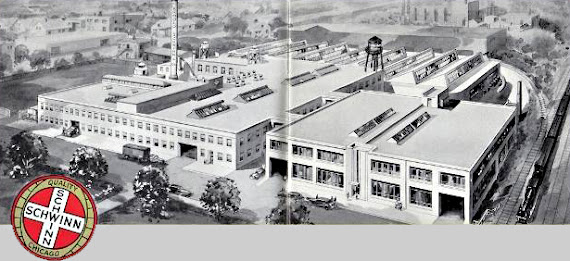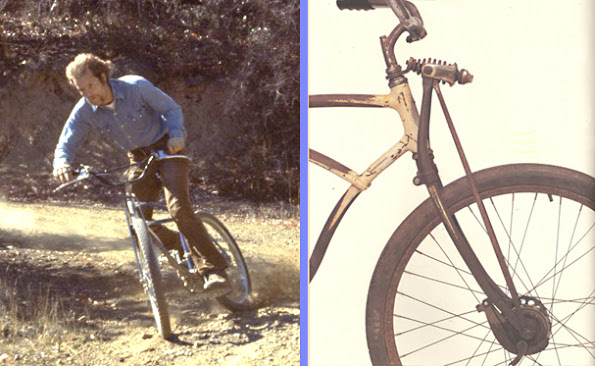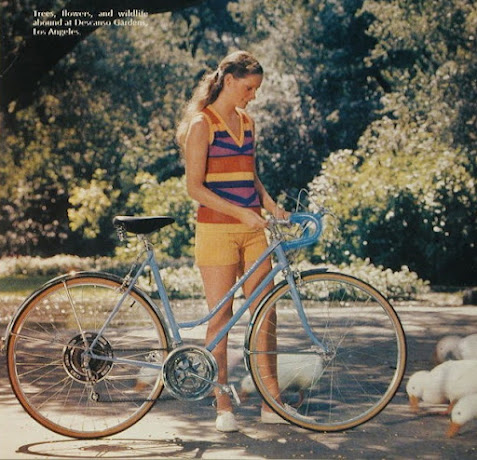 |
| Schwinn Varsity Sport, 1974 (Image: Schwinn Catalog, 1974) |
Schwinn was founded by Ignaz Schwinn during the safety bicycle boom of the 1890s. Around 1910 that boom turned to a bicycle bust and Ignaz Schwinn turned his attention towards motorcycles. He founded Excelsior motorcycles to counter the decline in bicycle sales. During this era of the early automobile, it seemed only normal to move from human-powered to motor-powered cycles. Despite the high quality of the motorcycles produced by Schwinn, in the late 1920s, the Great Depression put an end to this business. Schwinn returned to its roots in the 1930s and once again began to focus on high-quality bicycles. After 1930, Schwinn was very innovative and initiated models including the children's Autocycle and the adult Paramount.
During the 1950s, Schwinn continued to concentrate on children's bicycles and through clever advertising established itself as a cultural icon. The 1960s were good times for Schwinn as the bicycle market began to expand to include adults. With expanding sales during the 1970s bicycle boom, it appeared Schwinn could do nothing wrong. The death of its long-time president Frank W. Schwinn combined with new trends in both bicycle design and production laid the foundation for a series of missteps that would later culminate in critical challenges for the family business.
The full 1895-1992 history of the Schwinn family bicycle business can be found in a separate but much longer article called "A Short History of Vintage Schwinn Bicycles."
Booming Sales Clouded by Loss of Long Time President
Schwinn was riding high. The bicycle sales boom in the early 1970s meant that they could do no wrong. Bicycle sales for children continued to be strong. Schwinn had a slow start in producing the new popular 10-speeds but picked up steam by successfully selling the new Varsity line of bicycles to young adults. In 1971 Schwinn hit a new high in bicycle sales of 1.2 million bicycles and this included 326 thousand 10-speed bicycles (Pridmore, 2001). This amounted to a whopping 25% market share in 1970.
 |
| Schwinn and Raleigh Compete for Adult Bicyclists in the 1970s (Image: Doug Barnes of 1971 Raleigh and 1983 Schwinn Badges) |
Unfortunately, Frank V. Schwinn had a heart attack in 1974 not long after being appointed as head of the company. He would be in charge of the company until 1979 but psychologically never would get over his brush with death.
Schwinn needed a more decisive manager to deal with the company problems faced during the mid-1970s. The company was in the middle of dealing with growing imports. Frank V. Schwinn had to decide whether his company should continue a “Made in America” tradition that had served it well for several decades. He also had to deal with an aging and antiquated Chicago factory. Despite all of these problems, Schwinn was still a major force in the bicycle industry in the USA throughout the decade.
 |
| Schwinn's State of the Art Factory, Circa 1940s (Image: Made in Chicago Website) |
During the mid-1970s, the American bicycle industry was evolving from a business of supplying bicycles only to kids to also providing them for adults. Schwinn should have been ready for this trend because Frank W. Schwinn had tried to steer his company towards adult bicycles as early as 1939. He had introduced the Schwinn Paramount with expectations of a boom in sales that never materialized.
Made in America Gives Way to "Schwinn Approved"
In a twist of fate, just as adult bicycle sales were exploding, Schwinn did not have the desired lightweight models available in high volumes for its customer. The factory had invested heavily in electro-forged welding machines that were not suitable for modern types of steel. Breaking with their “Made in America” tradition, Schwinn temporarily solved this problem by importing bicycles from Japan and Taiwan. Schwinn was not alone as many other US manufacturers were beginning to outsource manufacturing to East Asia.
Schwinn imported its first Japanese-made bicycle model as early as 1972. Al Fritz had traveled to Japan to dictate the specifications for the new Japanese-made Schwinns. What emerged were two well-made bicycles worthy of the Schwinn name. One used the historic World label, a moniker first used by Schwinn in the 1890s. The second model was named the Schwinn Le Tour, a road bike destined to become a classic.
 |
| First Advertisement of Schwinn "Approved" Le Tour (Image: 1974 Schwinn Catalog) |
Slow Response to Popularity of BMX and Mountain Bikes
Schwinn also was slow to embrace this new type of bicycle emerging from a trend in California. In California, teenagers and pre-teens were fitting new seats and handlebars on their Stingrays to use them for both tricks and racing. The trend caught on and they were called BMX bicycles.
Schwinn was aware of the trend but saw it as a flash in the pan. Frank Schwinn was hesitant to enter the BMX market due to safety concerns. Schwinn also worried that they could not put a lifetime guarantee on bicycles ridden to their limit on BMX courses. Crashes and mangled bicycles were part of the rough and tumble world of BMX races.
Skip Hess, the founder of Mongoose, was quoted as saying “The (Schwinn) people in Chicago only heard the echo” of this new Trend (Crown and Coleman p. 109, slightly reworded). He established a new company named Motomag that first sold stronger wheels to modify existing Stingray-style bicycles. He even sold some as accessories through Schwinn bicycle shops.
In 1976, Hess established a new company called Mongoose to offer a complete line of BMX bicycles. This was a very good move because sales of BMX bicycles in the US surged from 140 thousand in 1974 to 1.75 million by 1977 (Crown and Coleman 1996).
The 1982 film ET (ExtraTerrestrial) illustrates the intensity of the BMX craze. A gaggle of boys riding BMX bicycles returning ET to his spaceship for his flight home evaded police by racing down streets, over curbs, and down hillsides. They eventually came to a police roadblock and magically rose in the air avoiding ETs capture.
An iconic Hollywood image emerged as they sailed through the air with their bikes silhouetted against a setting sun. In earlier years, Schwinn would have been all over this new craze.
 |
| Highlighting BMX Craze, Bicycles Carry ET to his Rocketship Ride Home, 1982 (Image: 1982 Film ET) |
 |
| Schwinn's First BMX Style Bicycle is the Scrambler, 1975 (Image: 1975 Schwinn Catalog) |
In 1980, this was followed by a higher quality BMX bicycle called the Sting. Schwinn was able to squeak out a 7 to 8 percent market share of BMX bicycles by 1980 but this was too little and too late. By then, other upstart manufactures of BMX bikes had captured the market and established their names. Schwinn’s BMX bicycles were left in the dust.
Mountain Bike Craze Begins with Baloon Tire Schwinns
Another change in the bicycle industry confronting Schwinn was a mountain bike craze emerging in Marin County, California. In another ironic twist, the creators of the mountain bike in trend-setting California were modifying old 1930s Schwinns because of their durability and coaster brakes.
Races down a rugged fire lane were taking place on a course they called Repack. They rode the old Schwinns hard and fast. What emerged from these races was a new style of bike that we know today as the mountain bike.
Schwinn was not convinced that the mountain bike craze would turn into sales opportunities. They couldn’t have been more wrong.
Without competition from Schwinn, the California entrepreneurs had an opening to develop bikes with suspension for riding on mountain trails. Joe Breeze, Charlie Kelly, Gary Fisher, and Tom Ritchey were avid Repack riders and realized that the old Schwinns being raced on the mountainside course had their limitations.
 |
| Joe Breeze on Repack and a 1949 Schwinn Autocycle with Drum Front Brake (Image: Charlie Kelly's Website, Accessed 2021) |
As if this wasn’t enough, Schwinn would be challenged in nearby Wisconsin by a new company called Trek. Sounding more like a hiking company, the company decided to build “Made in America” lightweight bikes to satisfy the growing demand for bicycle touring. They featured lightweight steel and brazed lugged frame construction.
In the late 1970s, Trek with its narrow range of specialized bicycles was no threat to mammoth Schwinn. Trek kept waiting for Schwinn to put the hammer down on them by building a line of competitive lightweight bicycles, but it never happened (Crown and Coleman 1996). This gave Trek some breathing room to diversify from its original touring bicycles to other models that would be in direct competition with Schwinn.
Trek at one point even made an overture to buy Schwinn in the early 1980s that was summarily rejected. The creativeness of the new company would continue during the ensuing decade when Schwinn was dealing with internal organization problems.
Young Edward Schwinn, Jr. Takes Over
In the late 1970s, Frank V. Schwinn relinquished his authority to manage the company. After just less than a decade running the company, Frank V. Schwinn decided to retire. He would retain the title of chairman and chief executive until he died in 1988. Schwinn had been managed by one person for over 40 years. Now Schwinn had to deal with the turnover of two chief executives in the space of 8 years.
In 1979, Ed Schwinn, Jr. took over the day-to-day management of the company. Ed Scwhinn, Jr was a 30-year-old great-grandson of founder Ignaz Schwinn. As the heir to the Schwinn family business, a young Ed Schwinn, Jr. would have to be very quick on his feet to meet all the challenges confronting the company.
Schwinn had a bicycle line that was identified as a children’s product. The Japanese were increasingly making inroads into the American market. Upstart niche bicycle manufacturers abounded. The Chicago factory was aging and in need of being upgraded or replaced. On top of all this, the Schwinn family wanted to retain full control of the company and therefore did not want to bring in private investors to pay for needed manufacturing upgrades.
 |
| A Young Edward Schwinn, Jr. Takes Over in 1979 (1983 Schwinn Lightweight Bicycles Catalog) |
Ed Schwinn, Jr. quickly ordered a management shakeup, The new chief executive surrounded himself with financial specialists. According to old-timers, “Regression analysis clashed with the glad-handing old boy school culture. (Crown and Coleman 1996, p142)“ Ed Schwinn,
Jr. broke with long-time managers including the well-respected Ray Burch and Al Fritz. Among others, a 25-year-old, inexperienced brother-in-law was hired to take their place along with a host of financial analysts and marketing specialists.
Ready or not, a youth movement was underway at Schwinn. The new team running Schwinn was young and brash. The question would be whether the new management team assembled by a young Ed Schwinn, Jr. could prepare the company for the coming decade.
Sales had decreased to 900 thousand bicycles by 1980. The new managers would have to deal with increasing competition, an aging factory, and whether to rely on imports as the mainstay of new bicycle production. The 1980s would prove to be a critical test for the Schwinn family business.
Additional Resources
This article is about Schwinn's history in the 1970s and it is also is part of the full history.
Again, the full history of the Schwinn family bicycle business 1895-1992 can be found in a separate, much longer article called "A Short History of Vintage Schwinn Bicycles."
Schwinn Catalogs provide an interesting source of Schwinn history and can be found at Vintage Schwinn Bicycle PDF Catalogs.



No comments:
Post a Comment